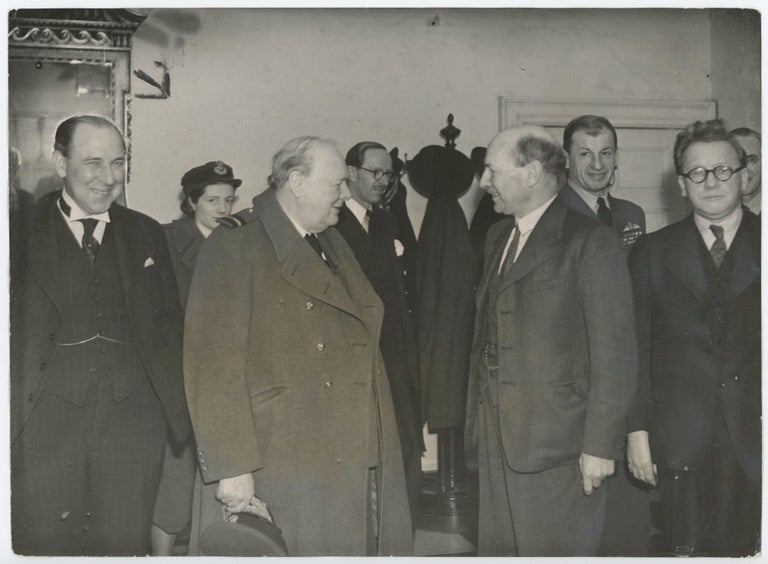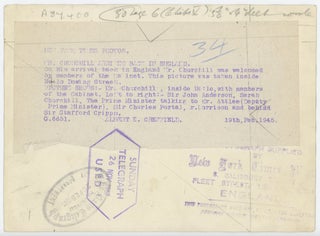MR. CHURCHILL ARRIVES BACK IN ENGLAND - An original Second World War press photograph of Prime Minister Winston S. Churchill, just returned from his final summit with Roosevelt and Stalin in Yalta, accompanied by his daughter Sarah and being greeted by members of his Cabinet including Clement Attlee, the man who would replace Churchill as Prime Minister five months later
London: Supplied by the New York Times, published by The Daily Telegraph, 20 February 1945. Photograph. This original Second World War press photograph was first published on 20 February 1945. It captures Prime Minister Winston Churchill at 10 Downing Street returning from the Yalta Conference with Roosevelt and Stalin, being greeted by Clement Attlee, the man who would replace Churchill as prime minister just five months later. The gelatin silver print is on heavy glossy paper and measures 8.125 x 6 inches (20.6 x 15.2 cm) Condition is very good, the image distinct, with minor wear mostly confined to the extremities, minor scratches and fingerprints apparent only under raking light, and a crop arrow on the left hand side of the photo. As evidenced by the stamps on the verso, this photograph was originally supplied by the New York Times and long held in British newspaper archives, published first by The Daily Telegraph on “20 FEB 1945” and again by the Sunday Telegraph on “26 NOV 1967”. The original printed caption affixed to the verso reads: "New York Times Photos. Mr. Churchill Arrives Back in England. On his arrival back in England, Mr. Churchill was welcomed by members of the Cabinet. This picture was taken inside No, 10 Downing Street. PICTURE SHOWS: - Mr. Churchill, inside No,. 10, with members of the Cabinet. Left to right: - Sir John Anderson, Sarah Churchill, The Prime Minister talking to Mr. Attlee (Deputy Prime Minister), Sir Charles Portal, Mr. Morrison and behind Sir Stafford Cripps. G. 6651 Albert E Craffield. 19 Feb 1945".
The Yalta Conference, also known as The Crimea Conference, was held at the Livadia Palace near Yalta in the Crimea from 4-11 February 1945. The negotiations, compromises, and concessions made at Yalta fundamentally shaped the postwar world, drawing the battle lines of the long Cold War to come. “The central, ever-present fact lying behind everything was that Stalin had an army of more than six million men in eastern Europe... The Western Allies thought they needed Russia to declare war against Japan once the German war was over, as they could not be certain that the atomic bomb – which for obvious reasons was not mentioned – actually worked.” Another constraining imperative was that “Churchill and Roosevelt wanted the Russians to engage meaningfully in the United Nations”. In sum, “There was idealism at Yalta as well as Realpolitik, but there was also lethal decision-making” and, for better and worse, the “Big Three... remade the world in eight days”. (Roberts, Walking With Destiny, pp.859-63)
Yalta was only one among many complications and disappointments Churchill faced in 1945. The next time Churchill returned home from a summit with the Soviets and Americans was only five months later, in late July 1945, but different in every respect. Truman had replaced Roosevelt, who died in April. Victory in Europe had been achieved in May. And Churchill returned home before the summit’s end, replaced by Attlee, whose Labour Party won the British General Election. Churchill would spend more time as Leader of the Opposition than he did as wartime Prime Minister before defeating Attlee’s Labour Party in October 1951 and reclaiming the premiership. Clement Richard Attlee (1883-1967) and Churchill took different paths to politics. Churchill chose and excelled at politics while still in his twenties and was first elected to Parliament in 1900. By contrast, Attlee had early careers first in the law and then in social work, which initially drew him to left-leaning politics. During the First World War, Attlee served with distinction, progressing to Captain and then to Major and seeing action at Gallipoli. Attlee first stood for Parliament as Labour candidate for Limehouse in 1919 and was elected in 1922, holding the seat until 1950. Attlee assumed a leadership role with his electorally crippled party in 1931 and became Labour Leader in 1935. He served in Churchill's wartime coalition government as Deputy Prime Minister (1942-1945) – the role he was still filling when he was captured greeting Churchill in this image. Item #005627
Price: $250.00


